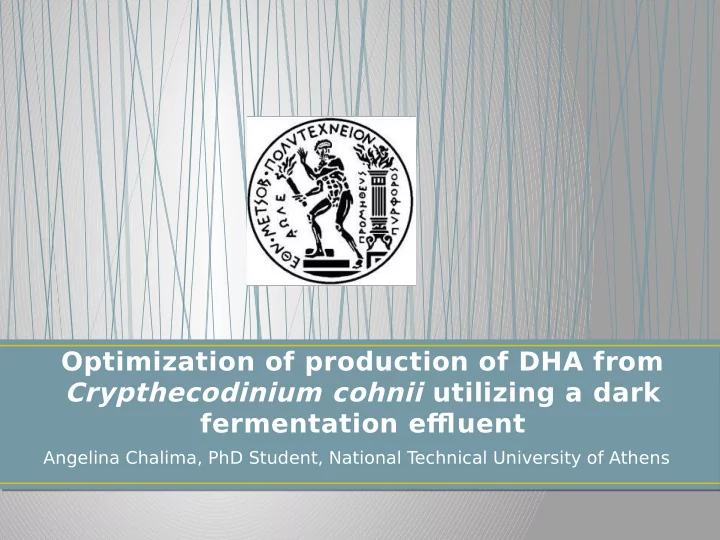

Optimization of production of DHA from Crypthecodinium cohnii utilizing a dark fermentation effmuent Angelina Chalima, PhD Student, National T echnical University of Athens
The accumulation of waste 19%
Bioconversion of biowaste to high added-value products (carotenoids, omega- 3, biopolymers…) Horizon 2020 Volatile Fatty Acids Platform from Biowaste by a dark fermentation process
Dark fermentation
Horizon 2020 Volatile Fatty Acids Platform from Biowaste by a dark fermentation process
Crypthecodinium cohnii • Marine dinofmagellate • High lipid content (<70%) • High percentage of DHA (docosahexaenoic acid) • Able to grow on glucose, acetate, ethanol Used commercially for the production of DHA by Martek Bioscience
So what did And then? you actually do? We examined We developed a C. cohnii fermentation growth on protocol in an the main VFA actual DF of a DF effmuent effmuent
Batch cultures of the strain Propionic acid Acetic acid Butyric acid Initial concentrations: 5- 50 g/L
Low biomass production/ Specifjc tolerance to each VFA/ pH rise
Fed-batch pH-auxostats 15 g/L sodium acetate 7.5 g/L yeast extract 25 g/L sea salts Acetic acid (33% v/v) Propionic acid (25% v/v) Butyric acid (25% v/v) DF ultrafjltrated effmuent Synthetic medium
12 days 48 h A. Chalima , et al. Integration of a dark fermentation effmuent in a microalgal-based biorefjnery Applied Energy 241 (2019) 130-138
Optimization Culture conditions Feed composition
Optimization of lipid production (1. culture conditions) • Difgerent T • Difgerent nitrogen sources Ammonium- Urea- Yeast extract- Nitrate 20-30 o C
Optimization of lipid production (1. culture conditions) • Difgerent C/N ratio 10-140 C/N=50 DHA=36 • Chemical modulators % Ethanolamine Salicylic acid
Optimization of lipid production (2. Feed) • Higher acid concentration DF effmuent Total VFA (g/L) #1 13.8 #2 24.6 60 28% h 48 h
Conclusions • Acetate, butyrate, propionate • DF effmuent (utilization of total organic content) Higher VFA concentration is favorable • Ammonium • 27 o C • C/N= 110
Gazing into the future… • Use of DF effmuent as an initial medium for the bioreactors more effjcient utilization (in progress…) • Examination of utilization of lactic acid • Application of a two-stage fermentation protocol “ The future starts today, not tomorrow…”
Thank you very much!! IndBioCat Group Volatile W.P 6 group Evangelos T opakas Maria Dimarogona Magdalini Krokida Anthi karnaouri Thomas Dietrich Natasa Zerva Alicia Paz Tecnalia Stratos Nikolaivits Georgia NTUA Asimakopoulou Biotechnology Grigoris Dedes Lab Christina Pentari
Recommend
More recommend